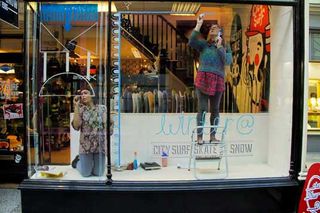Find new ways to earn cash from your design skills: 6 pro tips
Short of cash? Then follow the advice of these entrepreneurial creatives.
You're stuck in a rut. You've been illustrating for longer than you care to remember, but you're just not making the big bucks.
Truth is, if you're not seeing the results you want, simply changing your focus, finding new inspiration or widening your list of contacts can be the difference between just about paying the bills and having enough to buy your own studio or getting commissioned by Pixar.
So here are some helpful tips from a few inspiring individuals who were open to trying something a little different. If it worked for them – how hard can it be?
01. Be prepared to stretch yourself

Inspired by the aesthetic of old movie theatres, marquee lights and American diners, Romily Walden set up a business crafting high quality, affordable handmade lights and signs for personal and home use. Launched just six months ago, Walden's market research revealed a surprisingly unsaturated UK market. Plus the price bracket of those that did produce was insanely expensive.
She had to learn a lot before she could kickstart Milk Street Studios, but already, jobs and enquiries are starting to generate themselves. Her advice: "Make something you love and don't be afraid to stretch yourself. There are so many amazing processes and materials out there, and with the internet, there are tutorials on how to learn just about anything, so don't hold yourself back."
02. Make friends with creatives

Making (and keeping) friends with other creatives is a fundamental skill in finding profitable outlets for your creativity.
Self-taught Wales-based artist Phil Morgan has worked on an impressively large selection of projects and has recently finished a bunch of new illustrations for a poster campaign for the mobile network giffgaff. Joining social networks like Tumblr and Flickr has been a great help in finding a lot of his good work, he says.
Get the Creative Bloq Newsletter
Daily design news, reviews, how-tos and more, as picked by the editors.
"I simply ask questions to other creative people about how to take part and be involved with showing my work, and it just sort of took its course from there," the 35-year-old reveals.
But good old fashioned word of mouth works wonders too. Simply through a recommendation by a friend, Morgan has now been commissioned to create illustrations for a pilot film that could turn into a big advert. "It's one of the biggest things I've ever been involved in and I'm honoured to have been asked." Good contacts are like gold dust, so hold tight.
Founders of The Ladder-less Window Painting Co., Bethan Lewis and Catrin Brierley, believe networking is key. "Talk to everyone and always carry business cards – even on a night out," they say.
03. Identify a need and meet it

For some like Zoe Murphy, a member of School for Creative Startups,
spotting a gap in the market comes annoyingly naturally. This 28-year-old furniture designer makes recycled and handprinted furniture and textiles using environmentally responsible materials. Her work aims to encourage others to "love what belongs to them" and to reduce the amount of materials needlessly sent to landfill. "My objectives when designing my first piece of furniture were to solve a problem of waste in a way that made people more attached to the things they own," she shares.
After launching her creative career at her printed textile design degree show, she later went on to win places at shows like Tent London's graduate section. There she met buyers and made contacts with the press and the retail industry. She made a lot of sales straight away and so her business began. She's even had a TV show screen printing with Kirstie Allsopp on Kirstie's Vintage Home.
It just goes to show where there's a need, there's an opportunity for success. You simply need to be innovative and determined enough to find them.
04. Be open to new opportunities

Sometimes it's all about being in the right place at the right time. Cardiff-based duo Lewis and Brierley recently set up The Ladder-less Window Painting Co. after returning from their travels around India. Massive fans of pattern, print and colour, these creative ladies started painting all sorts of windows for events, promotions or simply to liven up a shop front.
"After being encouraged by friends with creative businesses, we decided to do something completely different and translated our Indian sketchbooks into an Indian memoirs window for Milgi Art Bar in Cardiff," they explain.
Since that first window, the commissions have been coming in thick and fast through various friends and approaching local businesses. "It's been surprisingly successful," they say. "It still amazes us how we're able to do these jobs after so little time and planning.
The advice from the pair would be to play to your strengths and don't be afraid to ask for something in return. If you can convince someone you're worth investing in, that's half the battle.
05. Do the maths
So when should you make your project your primary job? "I once read that you shouldn't think about quitting your day job until your creative project is making 40% of what you need to live on," shares 26-year-old Walden. "I think that's great advice. Don't jump ship without any sense of whether your idea can be profitable. If you really love your product, work on it on weekends and in every spare moment until you have real signs that it can turn into a business."
"Someone told me that without financial goals a business is just a hobby," she continues. "It can be scary and uncomfortable to look at the finance and what you want from your business, but it's both essential and motivating! As creatives we can be reluctant to look seriously at profit margins and the worth of our creativity, but it's important to become comfortable with that if your business is going to succeed. There's nothing worse than fulfilling an order and realising you've paid yourself less than minimum wage to do it!"
06. Mistakes to avoid
- Going with the obvious: Never go with your first idea. Try to come up with a few ideas so the client can give feedback, which you can go away and work on.
- Assuming every enquiry equals an order: You'll experience a lot of disappointment, so be prepared to roll with those punches. Some enquiries will come through!
- Underestimating what it will cost to produce your product or service: Budget everything into your costs, from packaging to bubble wrap, hanging fixtures, paint, nails, time and even shipping costs. If you don't, you'll be wondering why you've only made £10 when everything is done and dusted.
- Taking everything to heart: Learn to take criticism. Not everyone is going to like the stuff you draw.
- Alienating people: You'll miss out on opportunities. Be nice to people and you'll get work.
- Spending too much on your idea before finding out if it can be profitable: Try to keep costs as low as possible before investing a lot of money in your business.
Words: Margaux Doey

Thank you for reading 5 articles this month* Join now for unlimited access
Enjoy your first month for just £1 / $1 / €1
*Read 5 free articles per month without a subscription

Join now for unlimited access
Try first month for just £1 / $1 / €1
The Creative Bloq team is made up of a group of design fans, and has changed and evolved since Creative Bloq began back in 2012. The current website team consists of eight full-time members of staff: Editor Georgia Coggan, Deputy Editor Rosie Hilder, Ecommerce Editor Beren Neale, Senior News Editor Daniel Piper, Editor, Digital Art and 3D Ian Dean, Tech Reviews Editor Erlingur Einarsson, Ecommerce Writer Beth Nicholls and Staff Writer Natalie Fear, as well as a roster of freelancers from around the world. The ImagineFX magazine team also pitch in, ensuring that content from leading digital art publication ImagineFX is represented on Creative Bloq.
